Intralesional resection (C0 to C2)
1. Introduction
Preoperative management
Proper planning is instrumental in the management of primary spine tumors. A multidisciplinary approach may be required depending on the localization of the tumor.
Preoperative planning
Based on CT and MRI imaging, a plan should be prepared to determine:
- The need for embolization
- Whether spinal cord decompression is necessary and, if so, the amount of tissue to remove to achieve sufficient spinal cord decompression
- The size and optimal location of implants used
The relationship between the tumor and the vertebral artery is important and should be assessed with preoperative MRI and CT angiography.
The picture shows a right C1 lateral mass tumor.

Embolization
Embolization procedures are recommended to reduce operative blood loss in hypervascular tumors, especially during more extensive resections.
Embolization should be considered for hypervascular tumors, such as giant cell tumors, aneurysmal bone cysts, and hemangiomas.
The role of the embolization is:
- To reduce the vascularity of the tumor
- To facilitate dissection around the tumor
- Mapping of spinal cord vascular supply
Embolization on its own may also have a therapeutic effect.
This image shows the embolization of a hypervascular tumor.

Resection strategy
Most benign primary tumors will be localized in the posterior element with variable extension anteriorly. These tumors are approached and resected through a posterior approach only.
A wide visualization is essential in these cases. An adequate amount of healthy posterior arch should be removed.
The goal is to achieve:
- Good visualization of normal and abnormal anatomy
- Safe decompression of the neural elements

Reconstruction strategy
If a posterior element tumor only involves WBB segments 1 and/or 12, resection can be performed without the need for an instrumented fusion.
For resections leading to atlantooccipital instability, instrumentation should be performed from the occiput to two to three levels inferior to the tumor.
As the procedure is often curative, it is important to verify that the spine is reconstructed in good alignment, and a solid bony union should be attempted.

Case-based scenario
Every case is unique.
To illustrate the surgical principle of a posterior intralesional resection, including a significant portion of the lateral mass, we will use a C1 tumor in segments 1–4 of the WBB classification.

2. Patient positioning and approach
Patient preparation
The patient is placed prone.

Surgical access
A posterior midline approach to the upper cervical spine is performed.
A wider dissection will typically be performed for primary tumors compared to a trauma case.

3. Instrumentation for occipitocervical fixation
Introduction
Occipital plateThere are several plate systems available for the occiput. Their application is based on the same principles, and to illustrate these concepts, we will show the use of a plate placed in the midline, which allows for modularity and rotation when connecting to the rods.

Independently of the plate system used, its placement should be close to but still caudal to the external occipital protuberance (EOP).
Placement of the plate at the EOP will increase the risk of skin erosion.
A too-caudal position may compromise the foramen magnum.

The thickest part of the cranium is the dense ridge which runs vertically in line with the internal occipital crest.
The thickness of this crest is 11.5–15 mm in males and 10–12 mm in females, and it provides the best bone stock for screw purchase.
As you move laterally, this crest becomes thinner, and around 7–8 mm laterally to the midline, the bone thins out to a thickness of only 5–6 mm.

Another landmark with thicker bone is the superior nuchal line which runs horizontally.

Plate application
Use templates centered in the midline on the posterior aspect of the occiput to determine the optimal size and shape of the plate.

Once the optimal plate is chosen, mark the location of the central cranial screw entry point with the plate in place.

Set the drill guide to 8 mm (female) or 10 mm (male) and drill the central cranial screw hole.

Probe the screw hole to verify that the anterior cortex is still intact.

If intact, continue drilling in 2 mm increments until the anterior cortex is penetrated.

Insert a screw of appropriate length through the plate into the predrilled hole.

After insertion of the first screw, there is enough flexibility in the system to allow for adjustments. Ensure the plate is flush with the skull and that it is level.

Insert the remaining screws in the order 2–5, using the same drill technique as for the first screw, ensuring bicortical purchase.
However, take care during drilling of the lateral holes (2 and 3) as the bone will be thinner than in the midline (4 and 5).

Cervical screw fixation
C1 instrumentationThe C1 level is rarely included in the instrumentation for C1 and C2 tumors.
However, an uncompromised lateral mass may be instrumented upon the surgeon's preference.

For C1 tumors, C2 is instrumented bilaterally.
For C2 tumors, the C2 level is rarely included in the instrumentation. However, if the tumor is unilateral, the contralateral side may be instrumented upon the surgeon's preference.
For C2 fixation, the following options are available (in order of preference):
Consideration can be given to using pedicle or laminar screws when doing an occiput to C2 fusion, as the starting point for the pars screws may often compromise the facet joint.

Fixation can be achieved with either lateral mass screws, pedicle screws, or a combination of the two.
Because lateral mass fixation is generally sufficient and carries less risk, pedicle screw fixation is limited to rare cases where lateral mass fixation would be insufficient or is not possible.

4. Decompression
Remove the posterior arch of C1 according to the preoperative plan.
Dissection should progress from normal to abnormal tissues to protect normal neurological elements and facilitate dissection.
The C2 nerve root should be decompressed as well to avoid occipital neuralgia.

Dissection of the tumor should progress from normal to abnormal tissues to protect normal neurological elements and facilitate dissection.
Use reverse-angle curettes and pituitary rongeurs to debulk the tumor.
Spinal cord mobilization should be minimized to reduce the risk of neurological injury.
Be aware of anatomical variation of the vertebral artery. Avoid injuries based on preoperative planning.
The goal is to achieve gross total resection.
Intraoperative navigation can be used as an adjunct to maximize resection accuracy.
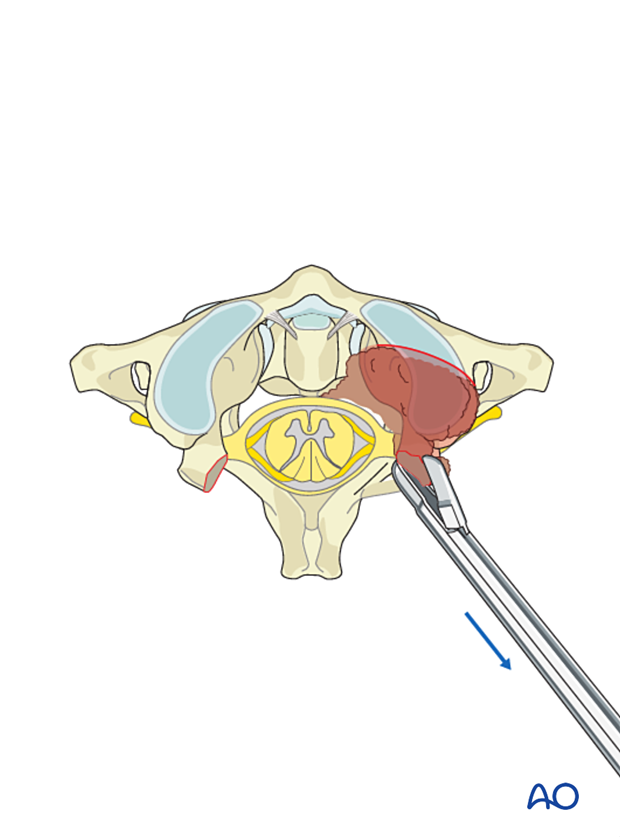
Once the tumor is entirely resected, the goal of the surgery is met.

5. Fusion
Decortication
Decorticate the lamina, facets, and posterior aspects of the skull.
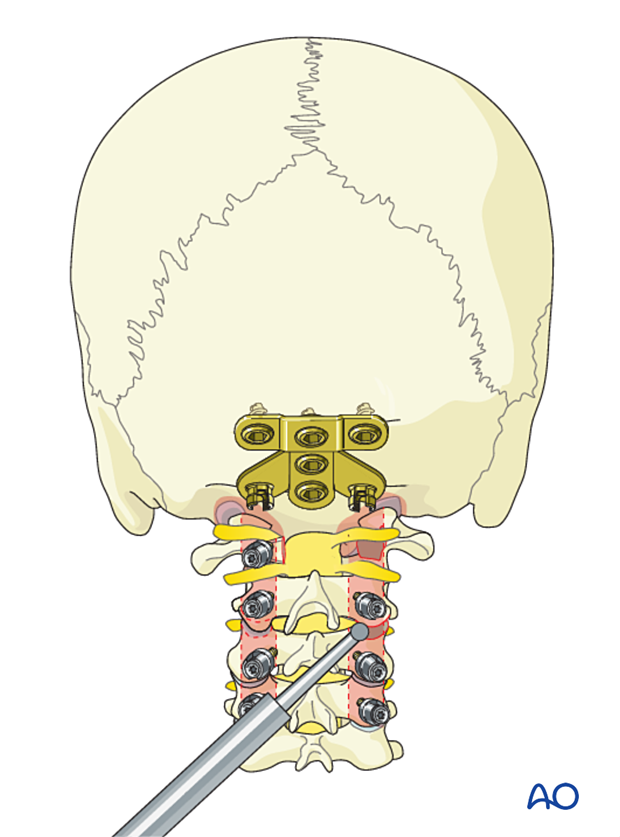
When using laminar screw fixation at C2, care must be taken not to decorticate deeply, as this might compromise screw fixation.
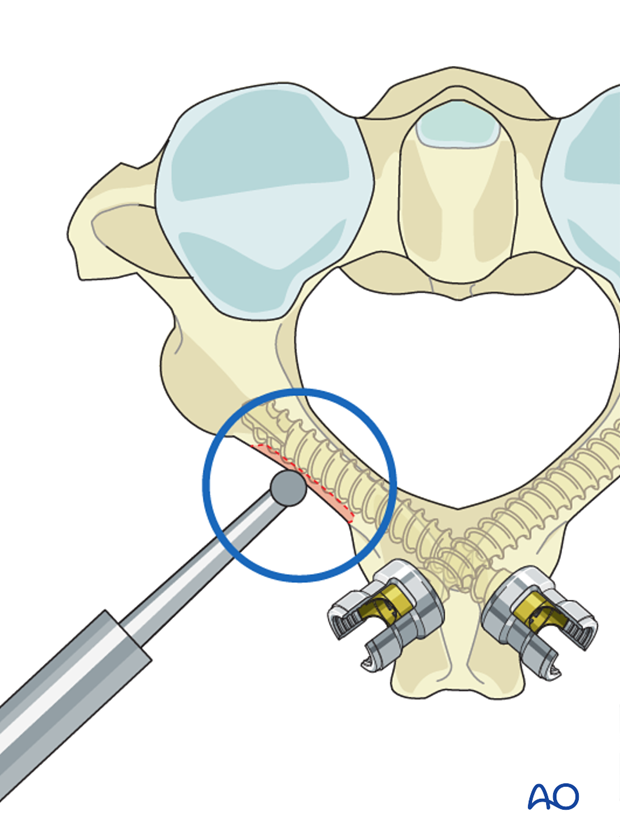
Alignment in the occipital cervical region
Align the head to allow for a horizontal gaze once the fusion is complete. Bend the rod accordingly.
Use the preoperative X-ray as a guide to properly align the occipitocervical junction during fusion.
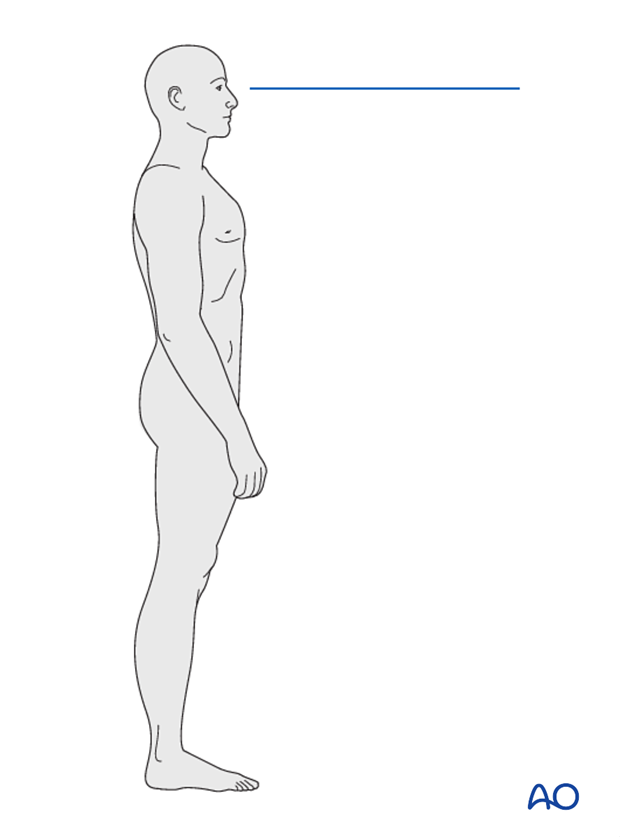
Rod application
Insert both rods when correct alignment is verified.

Grafting
Place bone grafting material against the decorticated elements of the spine.

6. Intraoperative imaging
Before wound closure, intraoperative imaging is performed to check the adequacy of reduction, position, and length of screws, and the overall coronal and sagittal spinal alignment.
Note that in this case, the C2 vertebra was not instrumentable on the tumor side. The construct was extended lower than usual (C5) to account for this and the poor bone quality of this patient.

Lateral view of the above case

7. Posterior closure
Perform a multilayer closure as described in the approach.
For patients undergoing tumor surgery and/or with a history of radiation:
- Plastic surgery should perform soft-tissue reconstruction to decrease the risk of wound complications
- Intrawound vancomycin can be applied to decrease the risk of postoperative wound complications

8. Aftercare
Patients are made to sit up in bed on the first day after surgery. Bracing is optional but preferably omitted for patient comfort. Patients with intact neurological status are made to stand and walk on the first day after surgery.
Patients can be discharged when medically stable or sent to a rehabilitation center if further care is necessary.
Throughout the hospital stay, adequate caloric intake of a high-quality diet should be monitored.
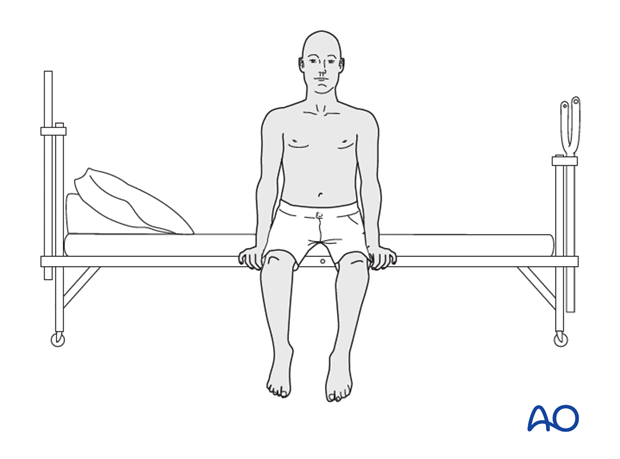
Patients are generally followed with periodical x-rays at 6 weeks, 3 months, 6 months, and 1 year to monitor for hardware failure and with an MRI every 6 months for tumor surveillance.
Some primary benign tumors of the spine can recur years after surgery, and long-term tumor surveillance is important.













